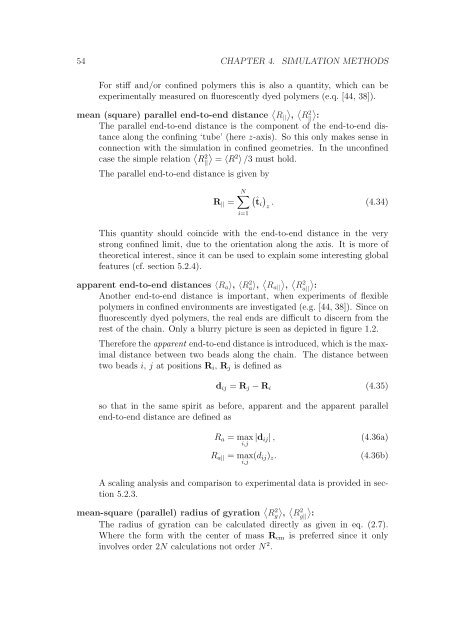Polymers in Confined Geometry.pdf
Polymers in Confined Geometry.pdf
Polymers in Confined Geometry.pdf
Create successful ePaper yourself
Turn your PDF publications into a flip-book with our unique Google optimized e-Paper software.
54 CHAPTER 4. SIMULATION METHODS<br />
For stiff and/or conf<strong>in</strong>ed polymers this is also a quantity, which can be<br />
experimentally measured on fluorescently dyed polymers (e.q. [44, 38]).<br />
mean (square) parallel end-to-end distance <br />
2<br />
R|| , R|| :<br />
The parallel end-to-end distance is the component of the end-to-end distance<br />
along the conf<strong>in</strong><strong>in</strong>g ‘tube’ (here z-axis). So this only makes sense <strong>in</strong><br />
connection with the simulation <strong>in</strong> conf<strong>in</strong>ed geometries. In the unconf<strong>in</strong>ed<br />
case the simple relation R2 <br />
2<br />
|| = 〈R 〉 /3 must hold.<br />
The parallel end-to-end distance is given by<br />
R|| =<br />
N<br />
i=1<br />
<br />
ˆti . (4.34)<br />
z<br />
This quantity should co<strong>in</strong>cide with the end-to-end distance <strong>in</strong> the very<br />
strong conf<strong>in</strong>ed limit, due to the orientation along the axis. It is more of<br />
theoretical <strong>in</strong>terest, s<strong>in</strong>ce it can be used to expla<strong>in</strong> some <strong>in</strong>terest<strong>in</strong>g global<br />
features (cf. section 5.2.4).<br />
apparent end-to-end distances 〈Ra〉, 〈R2 a〉, <br />
2<br />
Ra|| , Ra|| :<br />
Another end-to-end distance is important, when experiments of flexible<br />
polymers <strong>in</strong> conf<strong>in</strong>ed environments are <strong>in</strong>vestigated (e.g. [44, 38]). S<strong>in</strong>ce on<br />
fluorescently dyed polymers, the real ends are difficult to discern from the<br />
rest of the cha<strong>in</strong>. Only a blurry picture is seen as depicted <strong>in</strong> figure 1.2.<br />
Therefore the apparent end-to-end distance is <strong>in</strong>troduced, which is the maximal<br />
distance between two beads along the cha<strong>in</strong>. The distance between<br />
two beads i, j at positions Ri, Rj is def<strong>in</strong>ed as<br />
dij = Rj − Ri<br />
(4.35)<br />
so that <strong>in</strong> the same spirit as before, apparent and the apparent parallel<br />
end-to-end distance are def<strong>in</strong>ed as<br />
mean-square (parallel) radius of gyration R 2 g<br />
Ra = max |dij| , (4.36a)<br />
i,j<br />
Ra|| = max<br />
i,j (dij)z. (4.36b)<br />
A scal<strong>in</strong>g analysis and comparison to experimental data is provided <strong>in</strong> section<br />
5.2.3.<br />
<br />
2 , Rg|| :<br />
The radius of gyration can be calculated directly as given <strong>in</strong> eq. (2.7).<br />
Where the form with the center of mass Rcm is preferred s<strong>in</strong>ce it only<br />
<strong>in</strong>volves order 2N calculations not order N 2 .













